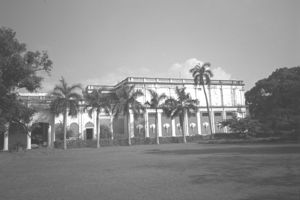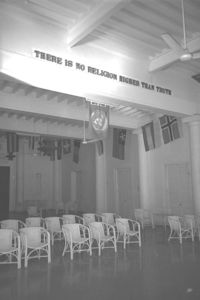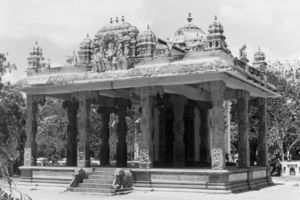Adyar International Headquarters
International headquarters of the Theosophical Society (TS) located on the south bank of the Adyar River in Chennai (formerly Madras), in Southern India.
Early History. On December 17, 1878, Helena Petrovna BLAVATSKY and Henry Steel OLCOTT, two of the founders of the TS, left New York, arriving in London on January 3, 1879. Leaving London on January 19, they reached Bombay on February 16, 1879, and established their Headquarters in that city. On May 31, 1882, during a tour of South India, they were shown Huddleston Gardens, an estate on the south bank of the Adyar River, near the city of Madras, with a large colonial style building with two outhouses. Olcott recorded in his diary that the moment Blavatsky and he saw it they knew that “our future home was found.” The two Founders took up residence at Adyar on December 19, 1882.
Improvements to the original building began as early as 1883. Within four years the first major alteration resulted in the present Headquarters Hall, where all important meetings are held. An extension for the newly established Adyar Library (which now houses the Society’s museum) with its striking outer paneled wall with eight sculptured elephant heads, was built during the following year and after the turn of the century modifications and additions continued to be made. It was above all the power, vision and spiritual energy of the early leaders which provided and inspired guidance that was to make of Adyar the “Flaming Center” of Theosophy which it is today.
Expansion under Annie Besant’s Presidency. When Annie BESANT became President in 1907, the Society’s estate comprised 27 acres. By the end of 1911 she had enlarged in to 253 acres by purchasing the properties now known as Alsace Grove, Blavatsky Gardens, Olcott Gardens, Besant Gardens and Damodar Gardens. Members sent generous contributions, while she herself repeatedly gave large sums to the Society out of her own earnings.
During Olcott’s time, Adyar was not yet a place for students, having accommodation only for the few workers necessary for the administration of the Society. Besant however, made arrangements for the accommodation of students wishing to stay for one or more years, to study and to help in the work. This necessitated the construction of special students’ quarters — the present Bhojanasala, Quadrangle and Leadbeater Chambers.
Blavatsky Bungalow, now used for the SCHOOL OF THE WISDOM, is a two-story building purchased from the Prince of Arcot along with about 80 acres of ground adjoining the previous eastern boundary. The title deeds were handed over by Annie Besant to the Theosophical Society on November 17, 1908, when the tablet on the east wall was unveiled, which reads:
“Presented to the Theosophical Society in loving memory of H. P. Blavatsky by some of her grateful pupils to whom she brought the Light — 17th Nov. 1908.”
Adyar Library. The Adyar Library and Research Center founded in 1886 by Colonel Olcott and opened formally at the 1886 Convention, has since become an oriental institute of world renown, attracting research scholars from all over the world. Due to its growth, it was shifted to a newly constructed and more spacious building in 1967-8.
The Library was started with a small but valuable collection of the Founders’ books, but soon Olcott realized that old palm-leaf manuscripts were lying, uncared for, throughout India and organized their collection with the help of scholars such as Otto F. Schrader. It now has 20,000 palm-leaf and paper manuscripts and more than 200,000 books, mostly in the field of eastern civilization, philosophy and religion and, of course, Theosophy.
About 200 rare and previously unpublished Sanskrit works in the manuscript collection have been edited and published as part of the Adyar Library Series. This Series also includes English translations of important works as well as studies by competent scholars. A series of distinguished scholars have acted as Directors and the Library is recognized as a research center for Ph.D. studies in Sanskrit and Indology by the University of Madras. Its journal, Brahma-Vidyā, presents papers on various aspects of religion, philosophy and Indology.
The Theosophical Publishing House. Founded in 1913, the Theosophical Publishing House has issued over 700 books, thus becoming one of the most important instruments for the dissemination of the teachings of Theosophy throughout the world. It also publishes The Theosophist, the official journal of the President and a quarterly, Adyar Newsletter. TPH moved to a newly constructed spacious building in Besant Gardens in 1987, after which the earlier premises, donated by Charles Harvey, were used for the administrative offices, lodging the Treasury and the Secretary’s and General Manager’s offices. The TPH also runs a Bookshop adjacent to the estate’s main gate which offers, in addition to theosophical literature, books on religion, yoga, mysticism, philosophy and allied subjects.
Vasanta Press. The Vasanta Press was opened in 1909. Its name is most appropriate since Vasanta is the Indianized form of Besant and it was Annie Besant who donated it to the Society. Since that time, the Press has continually been used to print theosophical literature. In 1971 it moved to a new building in Besant Gardens with better facilities for the staff and modern printing equipment.
The School of the Wisdom. The School of the Wisdom was officially opened on November 17, 1949, by C. JINARĀJADĀSA, fourth President of the Theosophical Society. Classes were held in the spacious Blavatsky Bungalow. The tranquil beauty of the campus, the treasures of the Adyar Library and Research Center, as well as contact with students from many other countries in quest of wisdom, provide students attending the School with unique opportunities. Its aims are:
To study the various aspects of the Divine Wisdom in general outline, emphasis being on equipping students with the knowledge and understanding necessary for them to be disseminators of Theosophical Truths. Also, to train workers for the Theosophical Society.
The central purpose of the School is to encourage participants to become genuine students of the Wisdom. Through study and reflection, students have an opportunity to develop creative insight into the fundamental principles governing man and the universe. The method of study is meant to stimulate individual thinking and exploration. The aim is to penetrate behind outer appearances to the inner Reality.
Museum and Archives. Located on the ground floor of the Headquarters Building, the Museum houses items of art and antiquity as well as mementoes of the early history of the Society, including a gilt bronze statuette of the Bodhisattva given to Olcott by the Ambassador of the Dalai Lama and referred to in his Old Diary Leaves; a fine marble sculpture presented in 1911 by the artist Mlle Henny Diderichsen of a girl holding her baby brother; a full-scale portrait of J. KRISHNAMURTI painted in 1913 by Alfred Hitchens, and a symbolic work of art named “The Messenger” by Nicholas ROERICH, painted in homage to Blavatsky, and presented by him to the Society in 1925. In the Archives are conserved theosophical manuscripts, correspondence and other important records, including the first manuscript of The Secret Doctrine copied by Constance WACHTMEISTER.
Shrines. Shrines of the different religions add lustre to the compound. The Headquarters Hall, conceived by Olcott, displays bas-relief symbols of living religious traditions and ancient ones now extinct. The statues of Blavatsky and Olcott are centrally located in an alcove under the Society’s motto, “There is no Religion Higher than Truth.”
The Hindu temple, Jyotiralaya, meaning Temple of Light, is non-sectarian, a flame in the sanctuary representing the Supreme Reality, but its finely sculptured pillars and porticos portray the complex symbols of Hindu mythology. It was consecrated in 1915 by Krishnamurti. Every morning at sunrise a simple ritual of worship (puja) centered round the GAYATRI mantra is conducted there.
Almost opposite is the church of St. Michael and All Angels where services are held on Sundays and special feast days. Midnight mass and other Christmas services draw members of all faiths.
The Buddhist shrine, with its lily pond in a well laid out garden of colorful shrubs, is a favorite place for quiet moments. An antique statue of the Buddha, a gift from Annie Besant, depicts the first sermon delivered in the deer park at Sarnath, as indicated by the wheel and the two deer at the foot of the statue. A Pāli inscription tells us: “He taught the cause of all things and also the means of cessation.”
Near the Christian church are also the Zoroastrian temple and the Sikh Gurudwara. Further on, near the approach to the seashore, is a mosque modeled on the Pearl Mosque in Delhi, “sitting like a jewel” amid the casuarina trees.
Olcott Memorial High School. Started in 1894 by Olcott, the School provides free education for almost 800 boys and girls from the under-privileged sections of society. It is entirely supported by the generosity of the Society’s members throughout the world. Located in the Besant Gardens area, the school gives the children, free of charge, nutritious breakfasts and midday meals. A specially designed Craft Center provides training in a variety of skills which help pupils to discover their own aptitudes and the options for their later life.
Social Welfare Center. Adjoining the compound, in the Society’s Social Welfare Center, opportunities are available for free nursery education for some 150 children in the neighborhood. They are given a nutritious breakfast in the morning and a midday meal. A free medical dispensary is also run, caring for over fifty outpatients daily. A tailoring section and a weaving unit provide training and a supplementary income for women from neighboring areas.
H. P. B. Hostel. Named after Madame Blavatsky, the hostel, founded in 1971, provides free board and lodging for some of the students of the Olcott Memorial High School who have potential abilities but lack home facilities for development. All the students in the Hostel are sponsored by Theosophical Society members or lodges in various countries. The hostel committee carefully selects boys in the 6-12 age group who continue living there until the completion of their schooling.
Banyan Tree and Gardens. The Adyar estate is a naturalist’s paradise with its gardens and wooded areas containing many indigenous and exotic species of plants and trees. It is also a sanctuary for a wide variety of birds and animals. Coconut, casuarina and stately mahogany trees abound in the compound. Copper pods (Peltophorum inerme), cannon-ball trees and baobabs from Africa add to its natural beauty. There are also many pipal or bodhi trees and several banyans. The Great Banyan Tree is famous and attracts thousands of visitors every month. It is about 450 years old, one of the oldest in India, and has a circumference of over 250 meters, occupying a total area of 4,670 square meters. Such eminent personalities as Mahātma Gandhi, the Dalai Lama, Annie Besant and J. Krishnamurti have lectured under it.
Adyar — A Spiritual Center. Apart from being the busy administrative headquarters of the world-wide Theosophical Society, Adyar is first and foremost a vibrant spiritual center where one can delve deeply into the profound aspects of existence and lead a life made meaningful through selfless service to humanity and all creatures. Generations of Theosophists have given of their best to maintain at Adyar an atmosphere of peace, tranquillity and upliftment. Commenting on the uniqueness of Adyar, J. Krishnamurti wrote:
“I have visited many wonderful lands and seen many a famous sight, but there is none equal to the extraordinary intangible something of our Adyar. There is an atmosphere there that does not exist in many a church and temple and there is a Presence there that we expect to perceive in a sacred shrine. One can become a God or a pitiful sinner at Adyar. It is a wondrous spot and it must be maintained as though it were a holy shrine.”
© Copyright by the Theosophical Publishing House, Manila


